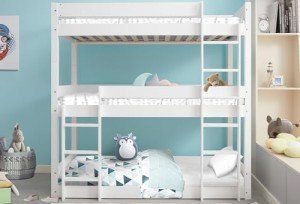15 Unquestionably Reasons To Love Bunk Beds
Exploring Bunk Beds: A Comprehensive Guide
Bunk beds have actually long been a staple in children's bed rooms, dormitories, and even homes with limited space. Not just do they offer a useful sleeping service, however they also produce a fun and creative environment for kids and a great space-saver for adults and households. This article will explore everything you need to understand about bunk beds, from types and materials to security suggestions and buying suggestions.
Table of Contents
- Kinds Of Bunk Beds
- Standard Bunk Beds
- Loft Beds
- Triple Bunk Beds
- L-Shaped Bunk Beds
- Product Options
- Wood
- Metal
- Safety Considerations
- Purchasing Guide
- Frequently asked questions
Types of Bunk Beds
cheap childrens bunk Beds (Frontnineadvisory.Com) beds come in different designs to fit various requirements and choices. Here's a breakdown of the most common types:

Conventional Bunk Beds
Traditional bunks typically include 2 beds stacked vertically on top of one another. These beds are ideal for brother or sisters sharing a room or for taking full advantage of sleeping space in guest spaces.
Loft Beds
Loft beds stand similarly to conventional bunk beds however do not have a lower sleeping location. Instead, they often incorporate a desk or seating location below, making them a great option for little spaces needing multifunctionality.
Triple Bunk Beds
Triple bunk beds are created for 3 occupants, with beds stacked in a three-tier configuration. These are less common but can be a fun solution for big families or slumber parties.
L-Shaped Bunk Beds
With one bed placed horizontally and the other vertically, L-shaped bunk beds are frequently geared up with extra functions such as desks or storage drawers and can complement corner spaces in a space.
Comparison of Bunk Bed Types
| Bed Type | Perfect Use | Description |
|---|---|---|
| Conventional | Shared bedrooms or visitor rooms | Two beds stacked vertically |
| Loft | Little spaces needing multi-purpose space | Upper bed with open space beneath |
| Triple | Big families or pajama parties | Three beds stacked vertically |
| L-Shaped | Corner or versatile spaces | A mix of vertical and horizontal beds |
Product Options
Bunk beds are manufactured from numerous products, with wood and metal being the most typical. Each product has its pros and cons.
Wood
- Toughness: Generally robust and can hold up against years of use.
- Visual Appeal: Offers a timeless look that can blend with numerous designs.
- Weight Capacity: Typically sturdier; can support much heavier weights.
- Drawbacks: May be more pricey than metal choices and can be prone to scratches.
Metal
- Strength: Generally lightweight and easy to move but still strong.
- Modern Design: Often can be found in sleek designs, making it appealing for contemporary spaces.
- Affordable: Usually more economical than wood alternatives.
- Drawbacks: Can be cold to the touch in winters and may not have the same aesthetic appeal for some buyers.
Safety Considerations
When it comes to bunk beds, security can not be ignored. Here are key safety suggestions to keep in mind:
- Guardrails: Ensure that the leading bunk has guardrails on both sides to avoid falls.
- Durable Construction: Check for a solid develop and tough products to stand up to weight and motion.
- Weight Limit: Adhere to the manufacturer's weight limitation for both the upper and lower bunks.
- Ladder Design: Choose bunks with a safe, easy-to-climb ladder and avoid any sharp edges or rungs.
- Age Restrictions: Most producers recommend that children under the age of 6 need to not sleep in the upper bunk.
Purchasing Guide
When looking for bunk beds, consider the following aspects to find the best fit for your needs:
- Space Availability: Measure the space size and ceiling height, ensuring there is adequate space for the leading bunk.
- Bed Size: Decide in between twin, complete, or larger sizes based on your needs and the size of the space.
- Design Preference: Consider the overall design of the bedroom to find a suitable style.
- Ease of Setup: Look for a bunk bed that is simple to put together.
- Budget plan: Bunk beds can be found in different price ranges, so identify a budget before beginning your search.
Frequently asked questions
1. What is the advised age for kids to sleep on the leading bunk?
Kids aged six and older are typically suggested to sleep on the leading bunk to minimize the danger of falls.
2. How can I make my bunk bed more secure?
To enhance security, ensure guardrails are properly set up and inspect that the bed is put on a flat surface. Furthermore, motivate kids to utilize the ladder carefully.
3. Can I transform a bunk bed into 2 different beds?
Numerous bunk beds are created to be convertible. Check the producer's specs for convertibility functions.
4. What accessories are available for bunk beds?
Common accessories include bed linens, storage drawers, staircases rather of ladders, and tented canopies for an enjoyable visual appeal.
5. How do I preserve my bunk bed?
Regular look for loose screws or structural integrity can assist make sure safety. Dust the bed routinely and clean spills immediately to keep the materials in good condition.
Bunk beds are versatile and a space-efficient solution for different living circumstances, from kids's rooms to guest lodgings. With numerous styles and products readily available, potential buyers have a wealth of options to consider, ensuring a mix of functionality and visual appeals. By focusing on security and following the ideas laid out in this guide, people can discover the ideal bunk bed that suits their space and lifestyle, all while producing a satisfying sleeping environment.





